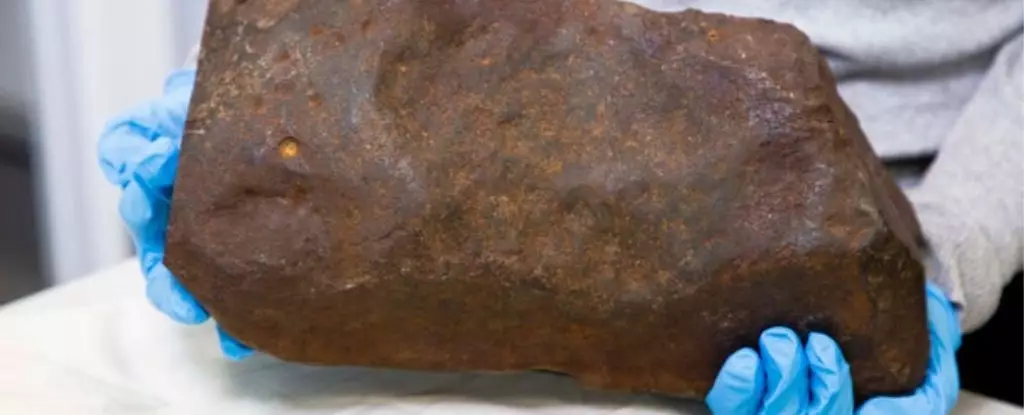In the serene landscapes of Maryborough Regional Park, located near Melbourne, Australia, an unexpected encounter changed the life of a curious metal detectorist named David Hole in 2015. While prospecting for gold—an endeavor familiar to enthusiasts in this historic Goldfields region—he stumbled upon an unusually hefty reddish rock nestled in yellow clay. The promise of a potential gold nugget excited him, fitting seamlessly into the dreams of many who have sought fortune on the very ground where gold rushes once thrived.
David’s determination to unveil the secrets of this rock led him on an obsessive quest. He employed various tools, including a rock saw, an angle grinder, and even a sledgehammer, yet each attempt to crack the exterior yielded no results. It wasn’t until he reached out to experts at the Melbourne Museum that the rock’s true identity was revealed, shifting the narrative from mere geological curiosity to a profound scientific discovery: it was a rare meteorite.
The Expert Examination
The allure of this discovery caught the attention of specialists like geologist Dermot Henry, who articulated the meteorite’s distinct characteristics. “It had this sculpted, dimpled look to it,” Henry explained, noting how meteorites often bear the marks of their fiery descent through the Earth’s atmosphere. A meteorite’s exterior often displays unique sculptural features that form as it melts during its atmospheric entry, a hallmark of their extraterrestrial origins.
The rigorous validation process at the museum resulted in a profound realization. After decades of scrutinizing thousands of submissions, Henry and his colleagues identified Hole’s find as one of only two verified meteorites they had encountered in their extensive careers. Bill Birch, another geologist at the museum, highlighted the meteorite’s unexpected heft compared to typical terrestrial rocks, adding an air of mystery to the artifact that soon captivated not just scientists, but the public imagination.
The meteorite, aptly named Maryborough, weighed an astonishing 17 kilograms (or 37.5 pounds) and was dated at an age of 4.6 billion years. Scientific analysis, using diamond saws to slice off segments, revealed its composition—a high concentration of iron, categorizing it as an H5 ordinary chondrite. Moreover, the interior boasted tiny, crystallized droplets of metallic minerals known as chondrules, further proving its cosmic origins.
Meteorites such as Maryborough serve as invaluable celestial time capsules, offering glimpses into the early solar system’s formation and the elemental processes that paved the way for planetary development, including Earth. Henry eloquently described meteorites’ role in science as “the cheapest form of space exploration,” emphasizing their potential to enhance our understanding of cosmic history and the very building blocks of life, including organic molecules and amino acids found in some rarer specimens.
The Astounding Journey Through Space and Time
While the specific trajectory of the Maryborough meteorite remains elusive, researchers speculate its origins trace back to the asteroid belt between Mars and Jupiter. Through a series of catastrophic collisions, it likely fragmented and eventually found its way to Earth, where it lay undiscovered for centuries. Carbon dating suggests its earthly residence might have spanned between 100 to 1,000 years, with records of meteor sightings between 1889 and 1951 hinting at possible entries into the Earth’s atmosphere.
Interestingly, the value of the Maryborough meteorite eclipses that of gold not just in rarity but also in scientific importance. Henry underscored this, noting it is the second largest chondritic mass recorded in Victoria, where only 17 meteorites have been documented compared to a plethora of gold nuggets unearthed in the region.
The story of the Maryborough meteorite serves as a reminder of the profound mysteries that exist just beneath our feet. It encourages us to reconsider how we view ordinary stones and rocks, inviting enthusiasts and laypersons alike to inspect their own findings with a discerning eye. Just as David Hole’s seemingly mundane discovery led to an extraordinary understanding of our universe, we too may find hidden treasures, metaphorical or literal, lurking in the familiar landscapes of our daily lives.
In a world where every chance finding can propel us towards greater knowledge, the tale of the Maryborough meteorite inspires us to explore, investigate, and embrace the possibility that there is much more to the world than meets the eye. So, the next time you stumble upon a rock that’s just a little too heavy to break, you might just be holding a piece of the cosmos.


Leave a Reply